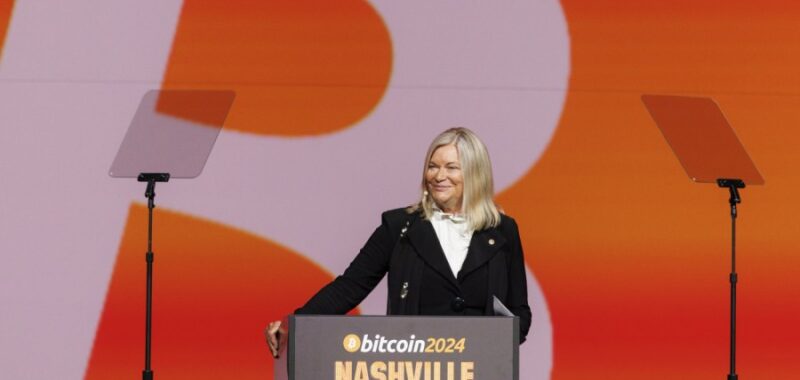
Speaking at the Nashville Bitcoin 2024 conference, Sen. Cynthia Lummis (R-Wyo.) floated a “revolutionary proposal” to make the federal government a Bitcoin investor. It is hard to imagine how this might benefit U.S. taxpayers or support the dollar’s value, but it certainly would raise the dollar price of Bitcoin.
While it is unsurprising that a plan to use taxpayer dollars to benefit foreign and domestic Bitcoin owners would have the Nashville audience cheering, it is impossible to justify. Neither the Federal Reserve nor the U.S. Treasury would want to or should be permitted to support Bitcoin’s price.
According to the accompanying statement issued by Lummis’s office, this proposal would create “a strategic Bitcoin reserve” of 1 million Bitcoins that the government would “would be required to hold … for 20 years.” We couldn’t have the government selling its Bitcoin and driving down the cryptocurrency’s price, now could we?
This plan is as quintessentially American as a Louis L’Amour novel about mining the Comstock Lode. In 1878, owners of silver mines in places like Virginia City, Nev., succeeded in lobbying Congress to pass the Bland-Allison Act which required the government to support the price of silver by buying and stockpiling large amounts.
Few ideas are new in politics or finance. Although a plan to force the federal government to buy something to support its price is hardly new, the proposed source of funds for these purchases is especially problematic.
In her Nashville remarks, Lummis said, “We will convert excess reserves at our 12 Federal Reserve banks into Bitcoin over five years. We have the money now!”
If by “excess reserves” Lummis means the “paid-in capital and surplus” of Federal Reserve district banks, as we have explained elsewhere, measured by generally accepted accounting standards, the Fed’s total paid-in capital and surplus account balance is negative $145 billion. Since September 2022, the Fed has had to borrow $145 billion just to fund its own expenses.
If the Fed is going to invest in Bitcoin, it would have to borrow even more money. Or it could sell some of its deeply underwater investments and book a big loss. Neither alternative makes sense.
Even if the Fed did have positive paid-in capital and surplus funds available to invest, there is a more fundamental problem. The Federal Reserve Act, as a bedrock principle, restricts the Fed’s open market investments to U.S. government obligations or instruments guaranteed by the federal government or its agencies. This law would have to be amended to allow the Fed to purchase Bitcoin.
If Congress did consider changing the act, other crypto coins and special interest assets would assuredly lobby Congress to be included as Fed-eligible investments. Such legislation would create enormous pressure to use the Fed’s monetary powers to purchase these assets, allocate credit and extend implicit subsidies.
Additionally, holding Bitcoin would create a large operating loss for the Fed. Bitcoin pays no interest, but the Fed has to pay interest on the money it borrows to finance its investments. At current rates, every dollar borrowed to hold Bitcoin would cost the Fed 5.4 percent in annual interest.
Suppose the Fed bought half a million Bitcoins at today’s price of about $60,000 each. At an interest cost of 5.4 percent, the Fed would incur operating cash losses of $1.6 billion a year on its Bitcoin investment. Over 20 years, the operating losses would total $32 billion, or more than 100 percent of the investment.
According to a report by CoinDesk, Lummis’s proposed Bitcoin Act of 2024 would also require the Treasury to revalue its gold stock and use the resulting capital gains to buy Bitcoin. We explained the mechanics of such a transaction in an article addressing the 2023 federal debt ceiling debate.
The current market price of gold is about $2,500 per ounce. The Treasury owns about 261.5 million ounces of gold. The Gold Reserve Act, amended in 1973, requires the Treasury to value its gold at $42.22 per ounce. At current market prices, the Treasury owns about $640 billion in gold but values it at a little over $11 billion.
If the law were changed to force the Treasury to revalue its gold, it could issue $629 billion in new gold certificates to the Fed in return for dollars. This accounting transaction would create $629 billion in newly-printed dollars for the Treasury to spend. Using an accounting adjustment to create $629 billion for the Treasury to spend on Bitcoin is inflationary and does nothing to enhance the value of the U.S. dollar.
From a risk exposure perspective, any federal government investment in Bitcoin would be leveraged speculation on the price of a notoriously volatile intangible asset.
Bitcoin enthusiasts and promoters have long claimed that Bitcoin will be an alternative to replace the dollar, allowing cryptocurrency users to escape the Fed, the Treasury and the U.S. government. Strategically, it’s extremely unlikely that the Fed and the Treasury will embrace this proposal as a cause to subsidize and promote.
The Treasury, in particular, reaps great advantages from the worldwide, massive holdings of U.S. dollar securities and currency — this is the famous “exorbitant privilege” of issuing the global reserve currency. It is central to financing the American government and American geopolitical power.
It is pretty hard to imagine the Treasury wanting to invest in an alternative asset that seeks to weaken or even end its crucial advantages.
The Bitcoin proposal claims it would “bolster” and “fortify” the U.S. dollar, but truth be told, it is a plan to bolster the value of Bitcoin that provides no benefit for the the dollar. Once the facts are understood, no U.S. taxpayer without Bitcoins would support a proposal to use their tax dollars to bolster its price.
A government Bitcoin reserve is just a bad idea.
Paul H. Kupiec is a senior fellow at the American Enterprise Institute. Alex J. Pollock is a senior fellow at the Mises Institute.

